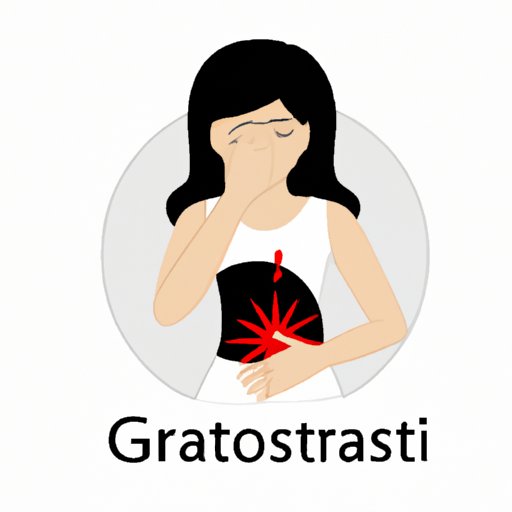
I. Introduction
Gastritis is a common digestive disorder that affects millions of people worldwide. Recognizing the symptoms of gastritis is essential for quick diagnosis and treatment, as untreated gastritis can lead to further complications. In this article, we will discuss the 10 common symptoms of gastritis, how gastritis can develop over time, different types of gastritis and their associated symptoms, and finally, what to do if you suspect you have gastritis.
II. 10 Common Gastritis Symptoms You Need to Know
1. Stomach pain
2. Nausea
3. Bloating
4. Vomiting
5. Loss of appetite
6. Belching
7. Indigestion
8. Abdominal discomfort
9. Acid reflux
10. Fatigue
Each of these symptoms can vary in severity and frequency. For instance, some people may only experience mild stomach pain, while others may suffer from frequent vomiting and indigestion. These symptoms can also worsen after consuming certain foods or drinks, such as caffeine, alcohol, or spicy foods.
III. Is Your Stomach Trying to Tell You Something? Recognizing Gastritis Symptoms
Gastritis can develop over time, and if left untreated, can lead to chronic pain and discomfort. Recognizing early symptoms is crucial for preventing further complications. If you experience any of the 10 common gastritis symptoms listed above, listen to your body and visit a doctor if your symptoms persist. Some tips for recognizing gastritis symptoms include:
- Keeping a food diary to identify trigger foods
- Taking note of the time of day you experience symptoms
- Monitoring the frequency and severity of your symptoms
IV. Gastritis 101: Signs and Symptoms to Watch Out For
There are two main types of gastritis: acute and chronic. Acute gastritis often develops suddenly and can be caused by medications, alcohol abuse, or bacterial infections such as Helicobacter pylori. Symptoms of acute gastritis can include stomach pain, nausea, vomiting, and loss of appetite.
Chronic gastritis, on the other hand, develops over time and can be caused by a range of factors such as autoimmune disorders, bacterial infections, or long-term use of NSAIDs. Symptoms of chronic gastritis include indigestion, bloating, and abdominal pain, and in some cases, may not present any symptoms at all.
If you suspect you have gastritis, it’s important to monitor your symptoms over time and seek medical advice if they persist.
V. When Your Stomach Starts to Act Up: Identifying Gastritis Symptoms
Real-life examples of how people experience gastritis can help you understand what to look for. For example, John often experiences bloating and indigestion after eating fried or oily foods. He also suffers from occasional stomach pain and nausea throughout the day. Sarah, on the other hand, experiences acid reflux, belching, and loss of appetite after drinking coffee or eating spicy foods.
It’s essential to take note of any recurring stomach problems you experience, as this may be a sign of gastritis. However, it’s important to differentiate between gastritis and other gastrointestinal issues, such as GERD or IBS, which can produce similar symptoms.
VI. Gastritis Symptoms: How to Recognize Them and What to Do When You Feel Them
If you suspect you have gastritis, it’s important to prepare for a doctor’s visit by recording your symptoms and any trigger foods or drinks. Your doctor may recommend additional testing, such as stool or blood tests, to determine the cause of your symptoms. Treatment options for gastritis may include:
- Antibiotics to treat bacterial infections
- Antacids to reduce stomach acid
- Proton pump inhibitors to reduce acid production in the stomach
- Lifestyle changes such as avoiding trigger foods or drinks and quitting smoking
It’s important to note that not all treatments work for everyone, and your doctor may need to adjust your treatment plan over time. Eating a healthy diet that is low in fat and high in fiber may also help reduce symptoms.
VII. Don’t Ignore These 7 Warning Signs of Gastritis
If you experience any of the following symptoms, you may be at risk of developing gastritis:
- Black or tarry stools
- Vomiting blood or coffee ground-like substance
- Severe stomach pain
- Shortness of breath
- Dizziness
- Chest pain
- Persistent vomiting or diarrhea
If you experience any of these warning signs, seek medical attention immediately, as these symptoms may indicate a more severe condition.
VIII. Stomach Problems? Could It Be Gastritis? Here’s How to Tell
If you’re experiencing any of the symptoms listed above, it’s important to seek medical advice. Gastritis can be managed with the right treatment plan, and early recognition of symptoms can prevent further complications.
Remember, everyone experiences gastritis differently, so it’s essential to listen to your body and work with your doctor to develop a treatment plan that works for you.
IX. Conclusion
Gastritis is a common digestive disorder that affects many people worldwide. Recognizing the symptoms of gastritis is essential for quick diagnosis and treatment, as untreated gastritis can lead to further complications. By following the tips in this article, you should now be equipped to recognize and manage gastritis effectively. Remember, if you suspect you have gastritis, seek medical advice and work with your doctor to develop a treatment plan that works for you.




